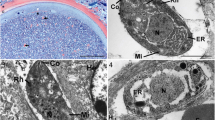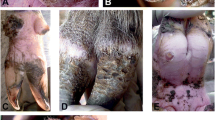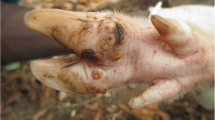Abstract
Tungiasis is endemic in many countries in Latin America, the Caribbean and sub-Saharan Africa, and it is associated with severe morbidity. The pathophysiological and immunological characteristics of the ectoparasitosis are not well understood, and no effective therapy is currently available. The aim of this study was to describe the natural history of tungiasis in laboratory-raised Wistar rats. The rats were exposed in the laboratory to the parasite or were kept in a natural environment with an intense transmission of Tunga penetrans. The time course of the infestation was determined, and lesions were photographed, described clinically in detail and biopsied. Biopsies were examined histopathologically and by light and scanning electron microscopy. Based on these findings, the natural history of tungiasis in Wistar rats was described and divided in five stages. Our data show that the natural history of tungiasis in Wistar rats and humans is almost identical, except that in the animals, the basement membrane disrupts 5 days after penetration and provokes an intense infiltration of the dermis, while in humans, the basement membrane remains intact. The study indicates that the Wistar rat is an appropriate model for the study of clinical and pathological aspects of tungiasis. Using this model should enable a better understanding of the pathophysiology and immunology of the ectoparasitosis.


















Similar content being viewed by others
References
Basler EA, Stephens JH, Tschen JA (1988) Tunga penetrans. Cutis 42:47–48
Bonnet G (1880) Mémoire sur la puce pénétrante, ou chique. tungiasis
Bruce CO, Knigin TD, Yolles SF (1942) A discussion of the chigoe (Tunga penetrans) based on experiences in British Guiana. Military Surgeon 82:446–452
Burmeister H (1853) Reise nach Brasilien, durch die Provinzen von Rio de Janeiro und Minas geraës. Georg Reimer, Berlin
Eisele M, Heukelbach J, van Marck E et al (2003) Investigations on the biology, epidemiology, pathology and control of Tunga penetrans in Brazil: I. Natural history of tungiasis in man. Parasitol Res 90:87–99
Faust EC, Maxwell TA (1930) The findings of the larvae of the chigo, Tunga penetrans, in scrapings from the human skin. Arch Dermatol Syphilol 22:94–97
Feldmeier H, Heukelbach J, Eisele M et al (2002) Bacterial superinfection in human tungiasis. Trop Med Int Health 7:559–564
Feldmeier H, Eisele M, Saboia-Moura RC, Heukelbach J (2003a) Severe tungiasis in underprivileged communities: case series from Brazil. Emerg Infect Dis 9:949–955
Feldmeier H, Heukelbach J, Eisele M et al (2003b) Investigations on the biology, epidemiology, pathology and control of Tunga penetrans in Brazil: III. Cytokine levels in peripheral blood of infected humans. Parasitol Res 91:298–303
Feldmeier H, Eisele M, Van ME et al (2004a) Investigations on the biology, epidemiology, pathology and control of Tunga penetrans in Brazil: IV. Clinical and histopathology. Parasitol Res 94:275–282
Feldmeier H, Witt LH, Schwalfenberg S et al (2004b) Investigations on the biology, epidemiology, pathology and control of Tunga penetrans in Brazil. V. Cytokine concentrations in experimentally infected Wistar rats. Parasitol Res 94:371–376
Franck S, Feldmeier H, Heukelbach J (2003) Tungiasis: more than an exotic nuisance. Travel Medicine and Infectious Disease 1:159–166
Fülleborn F (1908) Untersuchungen über den Sandfloh. Arch Schiffs Trop Hyg 6:269–273
Geigy R (1953) Sandfloh-Probleme. Naturwissenschaften 40:40–42
Geigy R, Herbig A (1949) Die Hypertrophie der Organe beim Weibchen von Tunga penetrans. Acta Trop 6:246–262
Geigy R, Suter P (1960) Zur Copulation der Flöhe. Rev Suisse Zool 67:206–210
Heukelbach J (2005a) Tungiasis. Rev Inst Med Trop São Paulo 47:307–313
Heukelbach J, de Oliveira FA, Hesse G, Feldmeier H (2001) Tungiasis: a neglected health problem of poor communities. Trop Med Int Health 6:267–272
Heukelbach J, Wilcke T, Eisele M, Feldmeier H (2002) Ectopic localization of tungiasis. Am J Trop Med Hyg 67:214–216
Heukelbach J, van Haeff E, Rump B et al (2003) Parasitic skin diseases: health care-seeking in a slum in north-east Brazil. Trop Med Int Health 8:368–373
Heukelbach J, Costa AM, Wilcke T, Mencke N, Feldmeier H (2004) The animal reservoir of Tunga penetrans in severely affected communities of north-east Brazil. Med Vet Entomol 18:329–335
Heukelbach J, Walton SF, Feldmeier H (2005) Ectoparasitic Infestations. Curr Infect Dis Rep 7:373–380
Ibanez-Bernal S, Velasco-Castrejon O (1996) New records of human tungiasis in Mexico (Siphonaptera:Tungidae). J Med Entomol 33:988–989
Joseph JK, Bazile J, Mutter J et al (2006) Tungiasis in rural Haiti: a community-based response. Trans R Soc Trop Med Hyg 100:970–974
Joyeux C, Sicé A (1937) Précis de médecine coloniale, 2nd edn. Masson et Cte, Paris, p 441
Lavoipierre MMJ, Radovsky FJ, Budwiser PD (1979) The feeding process of a tungid flea, Tunga monositus (Siphonaptera: Tungidae), and its relationship to the host inflammatory and repair response. J Med Entomol 15:187–217
Linardi PM (2000) Família tungidae. In: Linardi PM, Guimaraes LR (eds) Sifonápteros do Brasil, 1st edn. Museu de Zoologia da Universidade de São Paulo, São Paulo, pp 48–53
Muehlen M, Heukelbach J, Wilcke T et al (2003) Investigations on the biology, epidemiology, pathology and control of Tunga penetrans in Brazil II. Prevalence, parasite load and topographic distribution of lesions in the population of a traditional fishing village. Parasitol Res 90:449–455
Nagy N, Abari E, Calheiros CM et al (2007) Investigations on the biology, epidemiology, pathology and control of Tunga pentrans in Brazil. VII Investigations on the life cycle and morphology. Parasitol Res (in press)
Njeumi F, Nsangou C, Ndjend AG et al (2002) Tunga penetrans au Cameroun. Rev Méd Vét 153:176–180
Rietschel W (1989) Beobachtungen zum Sandfloh (Tunga penetrans) bei Mensch und Hund in Französisch-Guayana. Tierärztl Prax 17:189–193
Ugbomoiko US, Ofoezie IE, Heukelbach J (2007) Tungiasis: high prevalence, parasite load and morbidity in a rural community in Lagos State, Nigeria. Int J Dermatol 46:475–481
Up der Graff FW (1923) Head hunters of the Amazon—seven years of exploration and adventure. Garden City Publication, New York
von Humboldt A (1981) Südamerikanische Reise. Ullstein GmbH, Berlin
Witt LH, Linardi PM, Meckes O et al (2004) Blood-feeding of Tunga penetrans males. Med Vet Entomol 18:439–441
Witt LH, Heukelbach J, Schwalfenberg S et al (2007) Infestation of Wistar rats with Tunga penetrans in different microenvironments. Am J Trop Med Hyg 76:666–668
Acknowledgements
The study was supported by the DAAD-CAPES German-Brazilian academic exchange programme (Bonn, Germany; Brasília, Brazil) and by Komittee Ärzte für die Dritte Welt (Frankfurt, Germany). PML and RAR are research fellows from the Conselho Nacional de Desenvolvimento Científico e Tecnológico (CNPq/Brasil). The excellent secretarial assistance of Michi Feldmeier is greatly appreciated. The data are part of a medical thesis by LW.
Author information
Authors and Affiliations
Corresponding author
Rights and permissions
About this article
Cite this article
Feldmeier, H., Witt, L., Schwalfenberg, S. et al. Investigations on the biology, epidemiology, pathology and control of Tunga penetrans in Brazil. VI. Natural history of the infestation in laboratory-raised Wistar rats. Parasitol Res 102, 1–13 (2007). https://doi.org/10.1007/s00436-007-0731-4
Received:
Accepted:
Published:
Issue Date:
DOI: https://doi.org/10.1007/s00436-007-0731-4




